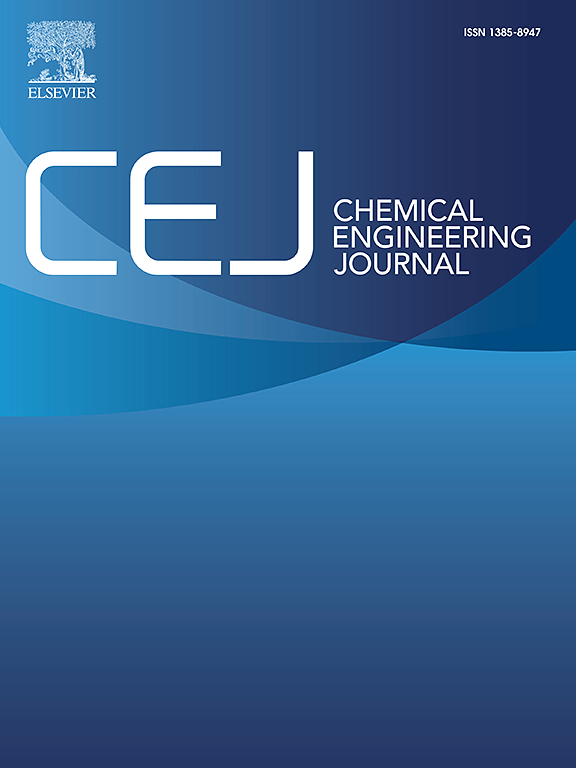Synergistic multiphase lattice strains and built-in electric field in lignin-derived carbon coupled with Mo-Cu-Ni multimetallic for enhanced urea-assisted water electrolysis
IF 13.2
1区 工程技术
Q1 ENGINEERING, CHEMICAL
引用次数: 0
Abstract
Nickel-based catalysts play a crucial role in urea-assisted water electrolysis but are hampered by uneven adsorption-desorption processes and slow kinetics in the urea oxidation reaction (UOR) and hydrogen evolution reaction (HER). In this study, we present a self-supported catalyst named MoO2/Cu/Ni@LC, which combines lignin-derived carbon with MoO2/Cu/Ni and grows on nickel foam. MoO2/Cu/Ni@LC features multiphase heterogeneous interfaces that induce interfacial lattice strains and built-in electric fields. These characteristics increase lattice distortions and optimize the electronic structure, thereby enhancing the intrinsic activity of UOR/HER. As a result, MoO2/Cu/Ni@LC achieves small/large current densities of ±10/±1500 mA cm−2 at 1.26/1.42 V (UOR) and − 65.55/−379.07 mV (HER). Moreover, MoO2/Cu/Ni@LC demonstrates remarkable stability by enduring 140 h of testing at ±500 mA cm−2 for both UOR and HER. This stability is attributed to the corrosion resistance of lignin-derived carbon, efficient electron transfer facilitated by multiphase heterogeneous interfaces, and a self-supported structure that enhances gas-liquid transport. Notably, when employed in a membrane electrode assembly, MoO2/Cu/Ni@LC exhibits an impressive low potential of 1.71 V at 500 mA cm−2 and maintains stable operation for 120 h. This work not only highlights a promising strategy for advancing nickel-based catalysts in practical urea-assisted water electrolysis applications but also offers valuable insights into designing catalysts for organic molecular oxidation reactions, such as those involving 5-hydroxymethylfurfural, methanol, etc.

木质素衍生碳与Mo-Cu-Ni多金属偶联的协同多相晶格应变和内置电场增强尿素辅助水电解
镍基催化剂在尿素辅助电解中发挥着重要的作用,但在尿素氧化反应(UOR)和析氢反应(HER)中,吸附-解吸过程不均匀、动力学缓慢等问题阻碍了镍基催化剂的发展。在本研究中,我们提出了一种名为MoO2/Cu/Ni@LC的自负载催化剂,该催化剂将木质素衍生碳与MoO2/Cu/Ni结合,并在泡沫镍上生长。MoO2/Cu/Ni@LC具有多相非均相界面,可诱导界面晶格应变和内置电场。这些特性增加了晶格畸变,优化了电子结构,从而提高了UOR/HER的固有活性。结果,MoO2/Cu/Ni@LC在1.26/1.42 V (UOR)和 - 65.55/−379.07 mV (HER)下实现了±10/±1500 mA cm−2的小/大电流密度。此外,MoO2/Cu/Ni@LC在UOR和HER的±500 mA cm−2下均能承受140 h的稳定性。这种稳定性归因于木质素衍生碳的耐腐蚀性,多相非均相界面促进的高效电子转移,以及增强气液输运的自支撑结构。值得注意的是,当用于膜电极组件时,MoO2/Cu/Ni@LC在500 mA cm−2时表现出令人印象深刻的1.71 V的低电位,并保持120 h的稳定运行。这项工作不仅突出了镍基催化剂在实际尿素辅助水电解中的应用前景,而且为有机分子氧化反应(如涉及5-羟甲基糠醛,甲醇等)的催化剂设计提供了有价值的见解。
本文章由计算机程序翻译,如有差异,请以英文原文为准。
求助全文
约1分钟内获得全文
求助全文
来源期刊

Chemical Engineering Journal
工程技术-工程:化工
CiteScore
21.70
自引率
9.30%
发文量
6781
审稿时长
2.4 months
期刊介绍:
The Chemical Engineering Journal is an international research journal that invites contributions of original and novel fundamental research. It aims to provide an international platform for presenting original fundamental research, interpretative reviews, and discussions on new developments in chemical engineering. The journal welcomes papers that describe novel theory and its practical application, as well as those that demonstrate the transfer of techniques from other disciplines. It also welcomes reports on carefully conducted experimental work that is soundly interpreted. The main focus of the journal is on original and rigorous research results that have broad significance. The Catalysis section within the Chemical Engineering Journal focuses specifically on Experimental and Theoretical studies in the fields of heterogeneous catalysis, molecular catalysis, and biocatalysis. These studies have industrial impact on various sectors such as chemicals, energy, materials, foods, healthcare, and environmental protection.
 求助内容:
求助内容: 应助结果提醒方式:
应助结果提醒方式:


